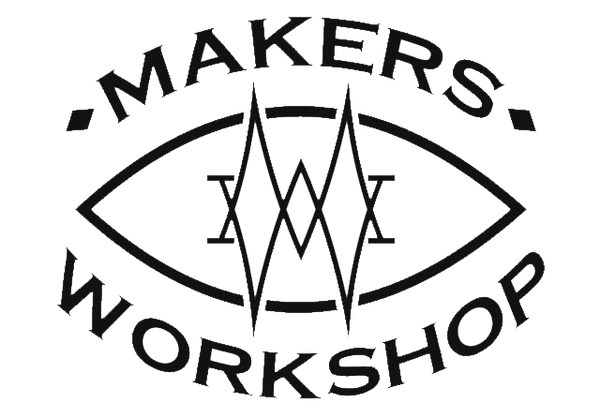The first order of business was cutting the walnut Stuart picked out down to the right rough size on the table sawr. Stuart wanted to add some resin, so he sketched out a curve he liked and cut it on the scroll saw.
Then it was time to put together a mold for the resin pour. One of my favorite techniques for smaller resin pours like this is to cover chipboard in Tyvek tape. It’s really easy to build a custom size box with, and is lightweight, but still leak proof.
Stuart hot glued his walnut pieces into place in the box so they wouldn’t float in the resin. We used Total Boat 2:1 with Medium Hardner and added a royal blue pigment to the resin for color.
Then it was time for the first pour. This particular resin can only handle about a ¼ inch pour at a time, so we let the first layer thicken up substantially before going in with the second and final pour.
One of the best parts about the chipboard mold is the ease of unmolding.
We then used the drum sander to flatten the faces of the piece.
After that, I used the table saw to square off all the sides and Stuart sanded everything down with a 220 grit sandpaper by hand.
The plan was to use dowels to form the 3 pieces into a U-shape. We sketched the thickness of the back piece onto the top and bottom to help map out where to drill holes for each dowel on the drill press.
We started out with a forstner bit to hollow out the two large spots for the cups to sit on the top resin piece. The forstner bit was clumsy so we changed from that to a hole saw instead. It was much faster and handled the material more smoothly.
At this point we had the idea to add lighting. I used the router table to add an inset over the dowel holes, and then Stuart went in and drilled a series of shallow holes that will house each LED.
From here, assembly was pretty straight forward. Stuart dipped each small dowel piece in wood glue and then tapped them into place using a rubber mallet.
For good measure we also added some more wood glue into the larger seam before using the mallet to smush it all together.
We began the same process for the bottom resin piece. This is the one that will house the LEDs. We wiped off the excess wood glue and then carefully placed a row of LED lights that were hot glued into place.
As I put the dowels together I also threaded wires through the LED holes drilled through the back piece. This will make it so all the wires are coming out of the back of the cup holder, towards the wall it will be mounted on. Once we were sure we had it all lined up we used a mallet to secure the bottom into place.
The glue dried up overnight, and then I gave it one last square off on the bandsaw. I also took a moment to round off the edges on the router table.
Stuart was going to hardwire this to the electrical system already on the boat, so all he did at the shop was solder all the positive wires together, and all the negative wires together to make it easier for installation later.
The finished cup holder came out fantastic.
After that, Stuart went back to Rhode island to make his boat. I didn’t help on that front, but we can all agree that the cup holder really tied the whole thing together. If you want to learn more about Stuart’s Boat restoration Senior Project, check out the blog at https://www.wemplephoto.com/the-refit
